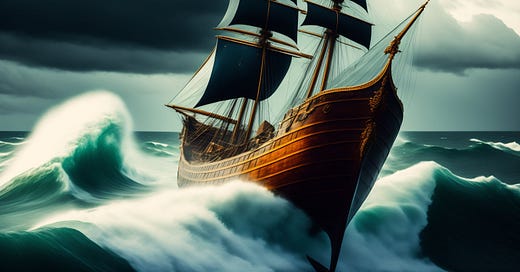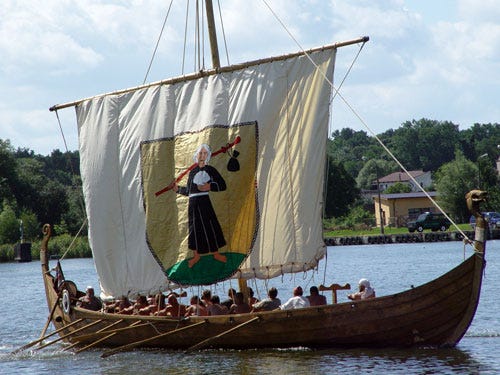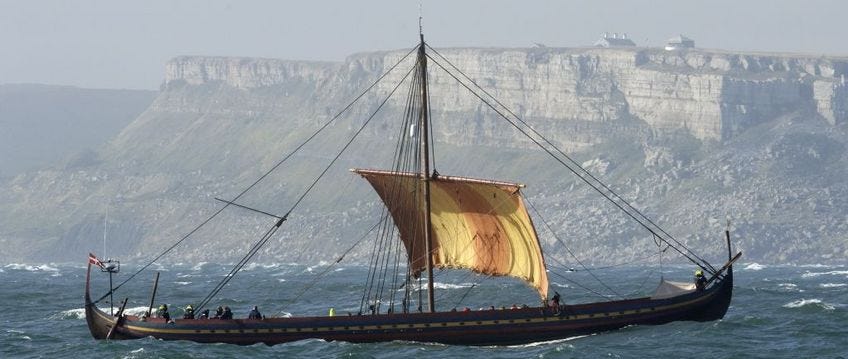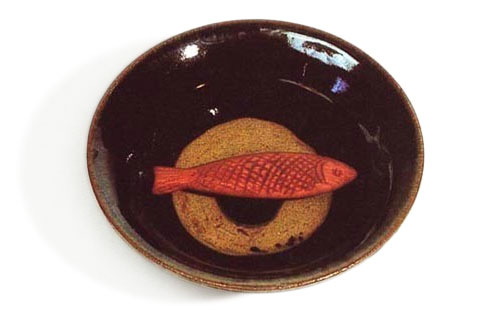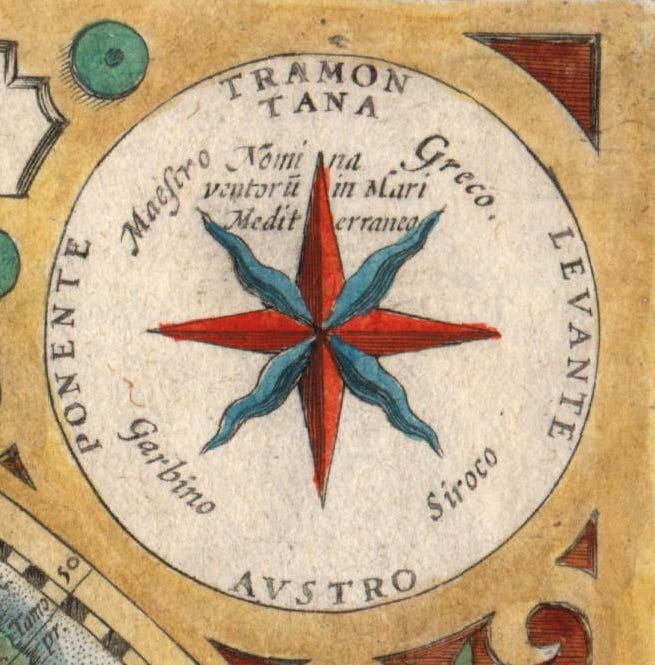Tall waves coming over the sea,
which the wind makes sway hither and thither
do you have any news of my lover,
who crossed the sea? I can't see him coming back!
Ah, god, this love!
Sometimes it gives me joy and sometimes pain!—Raimbaut de Vaqueiras, ca. 1200, translation via Trobar.org1
In our last post, we investigated travel in the Middle Ages, and more precisely travel on land. And concluded that a traveler on horseback might make 20-25 miles per day (or more), and a walker, 5-15 miles per day (or more), depending on conditions.
Today we’re going to look at travel by sea.
Richard was the first crusade leader to plan and execute a sail from Europe to the Holy Land (although King Philip of France would join him, and eventually beat him there). Previous crusades had gone overland toward Jerusalem. For example, during the Second Crusade, Richard’s mother Eleanor had joined her then-husband King Louis of France. They departed in June of 1147, headed toward Constantinople, and arrived in October, arrived at Ephesus (Turkey) December 1147, arrived in Antioch March 1148, and eventually saw Jerusalem in May 1148 - all in all, a journey of roughly one year, over a distance of (very roughly) 2500 miles, (roughly) 7 miles per day, with many a misadventure along the way. An admirable map of the Second Crusade history can be found here: https://history-maps.com/story/Second-Crusade.
Richard, no doubt advised by his mother, decided to sail to the Holy Land. Our friend Roger of Hoveden, one of Richard’s historians, writes that “It is worthy of remark, that from Marseilles to Acre is only fifteen days’ and nights’ sail, with a fair wind” but goes on to remark that one must therefore sail across the open sea (“yikes”, he might have said), and as we will see it will take both Richard and Philip much longer than this.
Richard went overland through France, to meet with King Philip of France, then overland to Marseille, and then by boat to Messina, Sicily and onward. His main fleet left London after Easter, on March 25, 1190. They would sail down the coast of Portugal, through the Straights of Gibraltar, and up to Marseille, arriving on Aug 22, missing Richard by a week. A journey of roughly 3,000 miles, an average of (again, roughly, 20 miles per day). An uneventful 20 miles per day, excepting their stop in Lisbon where drunk crusaders ran riot and hundreds were arrested, and eventually bailed out by the soon-to-be Grand Master of the Templars, Robert de Sablé. They were also distracted by a violent storm off the coast of Portugal. Richard’s main fleet would eventually join him in Sicily, and they would sail on together from there.
The total journey, from London to Acre, would be nearly 5,000 miles. They would winter in Messina, departing on April 10, 1191, and arriving in the Holy Land at Tyre, on June 6th. Their journey would be eventful: storms, shipwrecks, the conquering of Cyprus, and the eventual landing at Tyre. It would take around nine weeks. Philip’s journey, about 1100 miles of sea, was to be completely uneventful, and take about six weeks (March 30 - May 20), at a pace of about 25 miles per day.
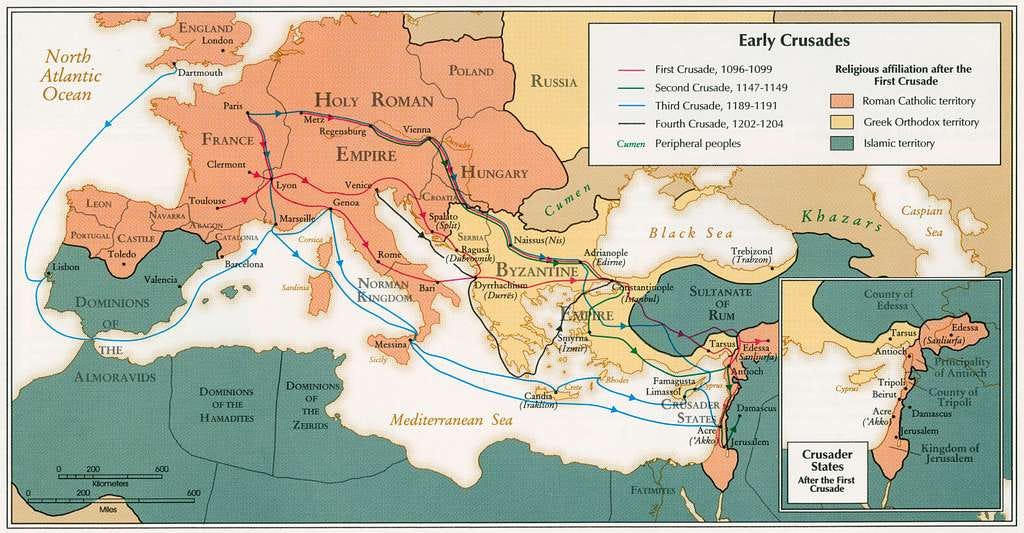
Richard’s fleet consisted of a motley arrangement of vessels. As today, medieval ships varied by their purpose: various forms of commercial trade vessels and ships for military usage. Richard’s fleet consisted of about two hundred ships: dromonds, busses, and the snekkars, the military war galleries. The two hundred ships carried what is estimated at around 17,000 troops.
Dromonds
The largest ships in Richard’s fleet were dromons. They are usually described as being 2- or 3-masted, and capable of carrying hundreds of men. In them, Richard placed Joan and Berengaria, as well as much of his treasure, and men to guard them. While descriptions of Richard’s fleet do not provide much detail, the dromon was originally of Byzantine origin and could be sailed or rowed. Richard will later sink an Muslim dromon with an estimated 600 on board.
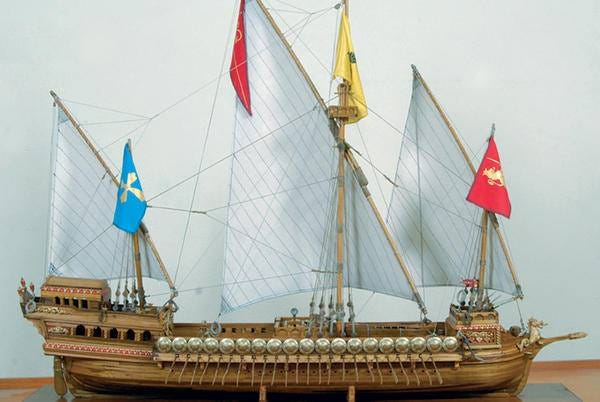
Busses
Busses were Richard’s cargo ships. They were evolved from the Viking longships, the knarr in particular, but larger and deeper, reportedly carrying 40 knights and their horses, and food for a year, which implies a hold, where the horses were kept in slings. So the “busses” of Richard’s time were probably more like the later ‘cogs’ with a below-decks, rather than a simple open boat like a Viking boat. In later centuries the buss would become heavily used in the North sea herring fishing industry. A few potential visualizations below. The busses (as well as the dromons) often had towers, usually aft (rear), and sometimes fore as well, for sighting as well as combat.

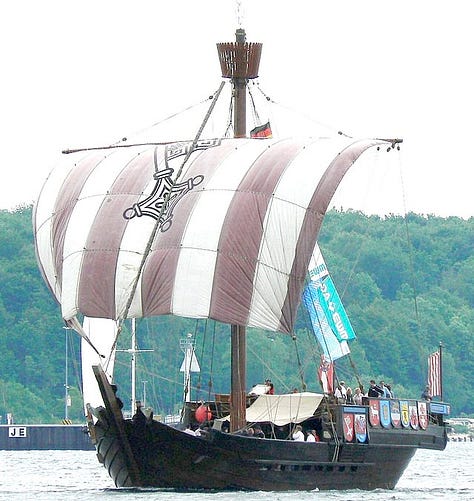
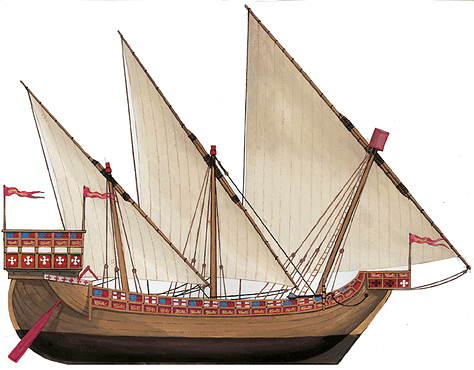
Snekkars
Snekkars (“enescas”, “esneckars”, “snakes”) were war galleys, evolved from the Viking longship. Fast and maneuverable, long and narrow, they were rowable as well as sailable. In Richard’s fleet, the galleys took up the rear of the line, herding the slower and more vulnerable cargo ships, much as destroyers protected convoys during the WWII war in the Atlantic.
Ambroise, another contemporary historian of Richard, was fond of referring to the fleet as the ‘fleet of snacks’. Whether this is a translator’s creativity or false cognate, or Ambroise’s original language, I do not know, but it is pretty amusing.
Contemporary histories are not clear on whether the snekkars in use by Richard had a hold below-decks. A traditional snekkar would be an open boat with no below-decks, but in later years it evolved into a larger format, the skeið2. Sailing across the Mediterranean in an open boat would certainly be possible, but not very comfortable, and the boats would be prone to swamping in bad weather. All in all it would argue for Richard's snekkars being larger than normal and probably having some form of below-deck storage. It's also important to point out that his boats were not actually Scandivanian, but rather influenced by their design, and the contemporary historians (and their translators!) probably reached for words they were familiar with.
To see images of all kinds of medieval ships, have a look at: https://naval-encyclopedia.com/medieval-ships.php
Navigation
In the age before GPS, how does one pilot a fleet of two hundred ships the 1,000+ miles, from Messina, Sicily to the Holy Land? Leaving Sicily, Richard’s fleet would sail for Crete, 500 miles away across the open ocean. Then on to Cyprus, another 500 miles, and then a short 100 mile hop to Tyre, in modern-day Lebanon.
As with land travel, maps were in short supply, and certainly not accurate in geometry. Similar to land travel, one often navigated from waypoint to waypoint. And as in Greek and Roman times, sailing across the open ocean was avoided. Generally ships would hug the coastline, sailing from city to city, as Richard did when he left Marseille and headed to Sicily. Amongst other things, this avoided sailing in the dark, where it was easy to get lost. Sailing the coastline of the Tyrrhenian Sea, he stopped in Genoa, Portofino, Civitavecchia near Rome, Naples, Salerno, and on down to Messina, turning it into a sightseeing trip as he went.
In this era, one navigated by the sun and stars, primarily, also using well-known landmarks (get it?). At this time, the compass has recently been invented / discovered / come into use in the Mediterranean—a topic which we will cover in a future blog post—but is not yet in heavy use for navigation. Living in Hawaii, and being familiar with the navigational techniques of the ancient Polynesians34, I am tempted to speculate that ocean swell directions, cloud formations, wind patterns, bird movements, and other natural phenomena played a role as well. In Richard’s case, while there no mention of it, it is also tempting to speculate that local captains, expert in the waters of the Mediterranean, were hired as guides.
Direction of sail was the other important constraint. The Europeans had not yet adopted the lateen-rigged (triangular) sail. All vessels were square-rigged sails. That meant that they could not sail into the wind, tacking to and fro, as modern sailboats do, and were much more at the mercy of the direction of wind. This form of sail, and sailing (tacking) was known to the Greeks, and to the Persians and Arabs as well (the exact origin and invention source is controversial5), but would not become commonplace in European sailing for a hundred years or more.
The Dangers
What dangers might they face? Well, there’s the Kraken.
Kidding, sort of. While we know that not to be true, medieval sailors had all manner of stories about the creatures of the deep: kraken, giant squid, the occasional siren, as tempted Odysseus6.
The more realistic danger, the primary one, was weather. Since the Greek era and before, few people sailed the Mediterranean from November to March, due to storms. And while Philip would have an uneventful sail, Richard’s fleet would leave in April and still encounter a massive storm that separated the fleet and sent some of them to Cyprus, where the ship carrying Joan and Berengaria would become an effective prisonor of Isaac Comnenus, the emperor of Cyprus. Two other of Richard’s ships would be shipwrecked there and many drowned, including Roger, the king’s Vice Chancellor. Roger had been wearing the king’s seal (for signing official papers) around his neck, and miraculously the seal was recovered!
Scurvy is a potential hazard. Scurvy is a Vitamin C deficiency caused by diet and a lack of fresh fruit. British sailors were given lime juice (hence the name “limey”) to combat it. However, scurvy generally takes at least 4 weeks or more of complete lack of vitamin C before becoming an issue, and symptoms make not occur for months. When Richard was in the Holy Land, he became ill with a mysterious disease his chroniclers called Arnaldia. Symptoms included hair and nails falling out, teeth falling out, and fever, amongst other things. While it is not certain, some researchers identify Arnaldia as scurvy (other candidates are trench mouth, alopecia, malaria, or some form of infection, and given how long ago it was, it’s possible it was a now extinct disease).
Seasickness was another danger. As the joke goes, you’re not going to die, you just wish you would. Seasickness was a common malady for crusaders, and most of the contemporary histories mention it in some way. In that day, some of the remedies involved ginger, pomegranate, and other spices, and the recommendation (as today), to not stay below decks. A medieval travel guide7 stated, “A place should be chosen remote from the bilge and the drains through which the fetid waters run. He should avoid whenever possible close quarters with men and their smelly limbs and, as a rule, should walk about on the highest parts of the ship to air and cleanse his garments of filthy fleas and lice and change and renew them as often as he can...”
Apparently Richard was not afflicted. Ambroise says, “we were afraid and uneasy, sick at heart, mouth and head” during the storm, but Richard of Devizes says “This also was admirable, that the king was no less cheerful and healthy, strong and mighty, light and gay, at sea, than he was wont to be by land.”
Lastly, Pirates. Depending on where you sailed, and how well armed you appeared to be, you might easily be troubled by pirates, captured and sold off into slavery. Probably not an issue for this fleet!
That’s it for today. Fair winds and following seas!
http://www.trobar.org/troubadours/raimbaut_de_vaqueiras/raimbaut_de_vaqueiras_24.php
https://en.wikipedia.org/wiki/Longship
https://www.hokulea.com/education-at-sea/polynesian-navigation/polynesian-non-instrument-wayfinding/
https://manoa.hawaii.edu/exploringourfluidearth/physical/navigation-and-transportation/wayfinding-and-navigation
https://www.jstor.org/stable/20078617
https://blackthornandstone.com/2020/05/21/here-be-monsters-sailor-stories-nautical-folklore/
https://www.cnrs-scrn.org/northern_mariner/vol14/tnm_14_3_69-72.pdf

